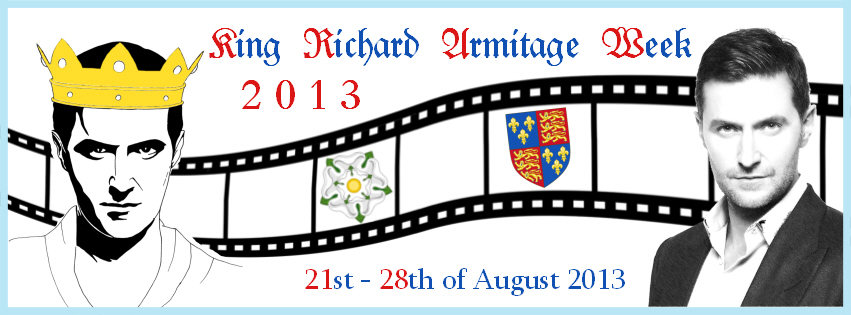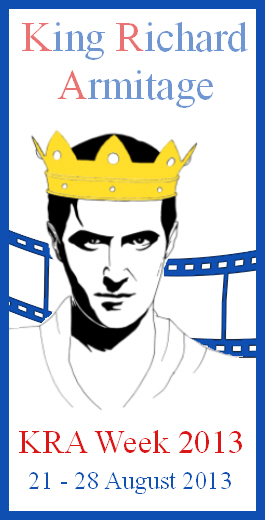KRA-Week 2013-8: Historical Music – The Orpheus Project
Links: King Richard Week 2013 & Quiz
! Attention !
The winners of the quiz are final and will be announced in a separate post today, where also the link to the quiz solutions will be revealed.
♕ ♛ ♕
King Richard III & Music
An interview with MaryAnn & Michael Tedstone
The Orpheus Project
Peter Warzynski in his interview (25.08.2013) gave us so insightful background information about Leicester and the euphoria about finding King Richard III there.
What better method is there to express happiness and joy than in music?
So I am very happy to present a Leicester based team of composers, MaryAnn & Michael Tedstone, with their group
The Orpheus Project
The two composers, MaryAnn & Michael Tedstone, brother and sister, are famous for their film music and their successful effort to combine old traditions with new musical elements.
They embrace the history and time of King Richard III and present musical elements and lyrics he might have known or heard himself in their new recording:
“The Last Plantagenet”
To tease you a bit with the wonderful music, here is a sample of “The Last Plantagenet”.
And I can assure you, it is worth having a look around the websites of the composer team, as their diverse music really is a joy and has a wide bandwidth of styles. I already spent quite a while on their websites and listened to their wonderful music:
- www.orpheusproject.co.uk
- www.manikemusic.com
- The Orpheus Project on SoundCloud
- ManikeMusic on SoundCloud
But now, I let them tell you themselves about their music and creative ideas behind “The Last Plantagenet”:
♛
How did the group “The Orpheus Project” come into existence and when?
The Orpheus Project came into existence in 2011, when we recorded an Album of Ancient Greco Roman music. We wanted to create an ensemble made up of musicians who are experts in their fields but do not have traditional early music training. I think that early music can be over stylised and I wanted the music to have a natural feel. I felt that by making a new ensemble and having a new look at how music is written and created, we could provide a refreshingly new sound to different periods of music.
Who composes / arranges / selects music / chooses, researches and finds texts / trains the group / records the music?
MaryAnn does most of the composition/arranging music selection and trains the group.
Michael records and produces the music. One of the things that makes The Orpheus Project unique is that we have our own industry standard studio. we are used to writing music and recording it for projects all over the world so it’s easy for us to make albums. We don’t have to worry about studio time and finding a good producer. We have one of the best music producers right here with us.
What is the background of your group and your individual musicians?
MaryAnn Tedstone studied Early music at the Guildhall School of Music and Drama with Philip Pickett.
Michael Tedstone studied music production at Alchemea College of music.
Glenn Sharp is a world music musician who play with the Jadid ensemble and is signed to Universal Music.
We use a variety of other musicians and vocalists who are experts in their fields. Each period calls for different instruments so it’s hard to give further information
Are your musicians only perform in this group or also individually or in other groups or ensembles?
Our musicians regularly play in other ensembles. Its what keeps us fresh and excited about what we do.
Why was this name chosen for the group? What connection does your group have to the Greek mythology?
When Orpheus called to his father Apollo, he did so on a golden lyre. I have always wondered what the music was that called the God Apollo down to Earth to help his son Orpheus. The Orpheus Project seemed like a good name. Our first Album was of Greco Roman music too. It also combines old and new which is what The Orpheus Project is all about.
Is your group mainly doing recordings or performing life?
The group does both live recordings and performs live.
Our next performance is for Leicester City Council where we are playing at a banquet.
I saw in the information, that you Ms Tedstone, are mainly composing film music and soundtracks for movie and film productions and advertisements. Is this also the direction of “The Orpheus Project” or to what purpose was this group created?
The Orpheus Project was intended to write music for historic documentaries and tv programmes but has become so much more due to the level of interest that we have received.
Why the title “The Last Plantagenet” for your CD? It gives already an interpretation of the events surrounding King Richard III’s demise in the Battle of Bosworth as well as the legitimacy of his royal succession. Is that intended or a reference to the last Plantagenet King on the throne of England or not an exact reference to King Richard III at all?
The album the Last Plantagenet is a reference to King Richard III. This album is music that he either might have heard, or music that has been specially composed in the style of the period.
What connection does the music have with King Richard III and are the music pieces new arrangements of old music or new arrangements ‘in-the-style-of’?
The Orpheus Project albums are intended to be a soundscape of what someone living in the period might have heard. For example our album SPQR is a representation of what Nero might have listened to.
Where do the texts / lyrics come from? E.g. the French text of the piece “Douce Dame”.
The Texts are all original. There are two by Dufay and One from Machaut.
If they are historic texts, would they be something Richard III could have had access to?
Yes we think King Richard III might have heard Douce Dame.
What image of King Richard III does the music promote?
(e.g. Richard III as courtier, as religious person of his time, as entertainment and music loving noble of his time,…)
I hope that the music makes you think that if King Richard III was riding through the streets of Leicester he might have heard something like our music playing in the street or in a pub.
What is your / your group’s connection to King Richard III?
We became interested in King Richard III when his body was found in a car park in Leicester and we started researching the music straight away.
What determined your choice of instruments in your group?
Not every travelling troupe of musicians would have had every instrument available to them. I felt that the lute and the hurdy gurdy were expensive instruments and so we should have only one. We chose lute. We have thought about what would happen to instruments when musicians of the period slept in fields or woods in between towns and we think that would have been really bad for all the instruments. Hopefully they put them in wooden cases.
Will your group get any official involvement in the ceremonies around King Richard III’s reburial next year?
We are officially involved with Leicester council. They are selling our CD in the museum and promoting us as much as they can. The re-burial is a church event and I have no idea at this stage how much involvement we will have.
What are your / your groups next plans for recordings? Is there more in store for all Richard III and late 15th century music fans?
We are thinking of looking at Robin Hood next which is not too far away from King Richard III. Stay tuned on our website www.orpheusproject.co.uk for more details.
Now that is good news for all Richard Armitage fans. Hopefully Sir Guy of Gisborne gets an extra place and special representation in the new music-project.
We will also keep you informed when the music of “The Last Plantagenet” will become available on iTunes in September 2013.
So far, you can order the CD version – £ 9,99 (PayPal payments accepted) – via alex@manikemusic.com.
(Please get in contact for delivery rates, though they are very decent and partially free of charge and the CD is sent out worldwide.)
Links: King Richard Week 2013 & Quiz
KRA-Week 2013-5: Fitzg – Sumptuary Laws
Links: King Richard Week 2013 & Quiz
♕ ♛ ♕
SUMPTUARY
Sumptuary laws
in Medieval and late medieval England.
(by Fitzg)
“Laws made for the purpose of restraining luxury or extravagance, particularly against inordinate expenditure in the matter of apparel, food, furniture etc.”
Black’s Law Dictionary.
English Sumptuary Laws date from 1281 in extant documents. They were then an expression of the Feudal System (every man in his place, dressed according his station. Women too.) The hierarchy must be established according to the “natural law”.
The next documented Law is that of 1309. This relates to conspicuous food consumptions of the nobles. (Peacocks presented at table, complete with feathers re-attached to the roasted fowl…)
Perhaps Edward III felt that such expenditure by his magnates reduced their monetary contributions to his Scottish and overseas wars.
Obviously, Kings and their families were not restricted by such fiscal management restraints.
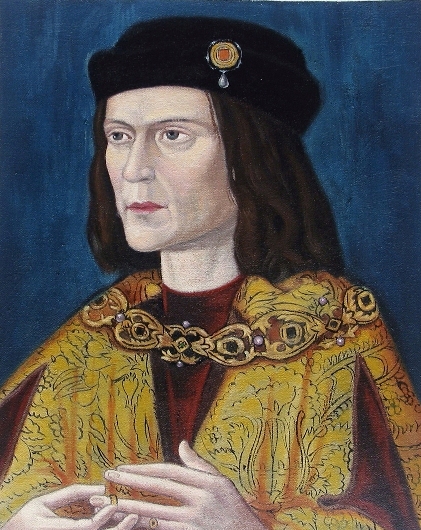
cloth of gold – Richard III earliest known copy of original; dated early 16th century (Source: Society of Antiquaries, London – Wikipedia)
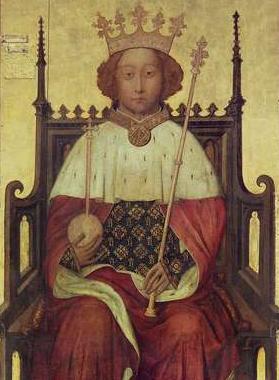
Richard II, c. 1390s. (Source: Westminster Abbey – Wikipedia)

Wilton Diptych (Source: National Portrait Gallery, London – Wikipedia)
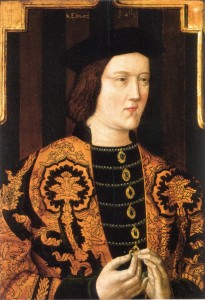
Edward IV. Portrait early 16th century (Source: Society of Antiquaries – Wikipedia)
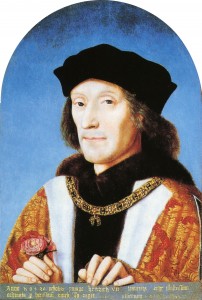
Henry VII, c. 1505 (Source: National Portrait Gallery, London – Wikipedia)
Cloth of gold, fur, gold…. It appears that the first Tudor, despite a somewhat austere, penny-pinching reputation, at least in the popular version, was not averse to personal display.
However, there was considerable Church disapproval of courtly display of fashion “trends“. Shoes, in 15th C, were an issue with the Church: the vanity of the elongated toes.
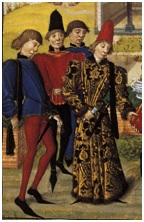 |
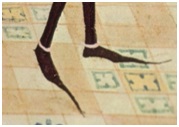 |
 |
And then, there was the Disney head dress. The Henin, and variations thereof.
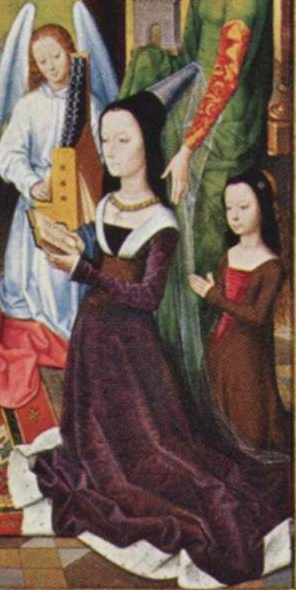
Hans Memling, Lady Donne of Kidwelly. The Donne Triptych, c. 1478 (Source: Wikipedia)
The middle class was rising in wealth, and becoming uppity in dress. Note the quantities of costly material in the sleeves and gowns and richness of dyes.

Hans Fouquet, the Melun Dipptych, c. 1452 (Source: Wikipedia)
Etienne Chevalier, was not a merchant, but a trusted civil servant.
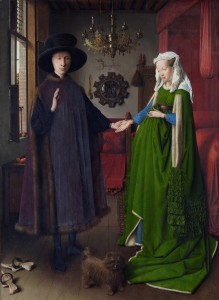
The Arnolfini Wedding, Jan van Eyck, c. 1434 – Italian merchant and his wife (Source: National Portrait Gallery, London – Wikipedia)
Disconcertingly to the “enforcers” of the Sumptuary Laws, the merchant class rose inexorably. The merchant class accumulated wealth, based on wool and textiles, and import/export. They bought off the enforcers’ fines, and even lent funds to cash-strapped nobility. They were going to wear what they had earned. Their wives (and often mercantile partners/supporters) were an advertisement to their wealth and their often mutual hard work. (Take that, Enforcers! 😀 )
England has not been quite as rigidly class-ridden as might be thought – upward mobility was mobilised. From 15th century sheep farmers, the Churchills were Dukes of Marlborough two centuries later. A middle class was firmly rising throughout Europe, driven by trade – wool/textiles/luxury goods from the East. The sheep farmers became merchants (and money-lenders), married into gentry and titled families, became senior civil servants.
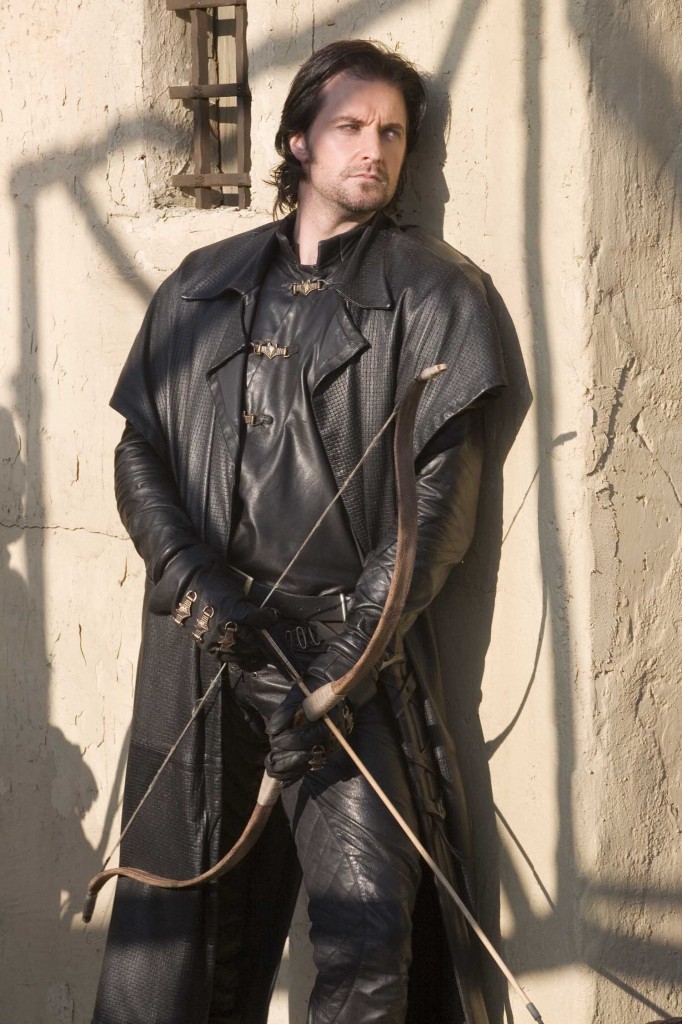
BBC “Robin Hood” Guy of Gisborne (Source: RichardArmitageNet.com)
Sir Guy of Gisborne, dressed head to toe in costly leather. Would a minor knight, in possession of an obscure provincial manor, pass the Sumptuary laws? Leather tanning and production were extremely costly, as is the case today. Perhaps; it didn’t involve cloth of gold or furs….
And Many Happy Returns to Richard Armitage on August 22 2013.
Respects to King Richard III, may he please be laid to rest as befits an anointed monarch.
SOURCES (for the costume-obsessed)
- www.medieval-life-and-times.info-medieval-clothing/medieval-sumptuary-laws.htm
- www.medieval-castle-siege-weapons.com/medieval-clothing.htm
- www.batashoemuseum.ca/collections/permanent/history_western_fashions/medieval/index.hstml
- Boucher, Francois. 20,000 Years of Fashion; Henry H. Abrams Inc. New York.
Links: King Richard Week 2013 & Quiz
Portraits of a King
♛ Portraits of a King ♛
by Fitzg
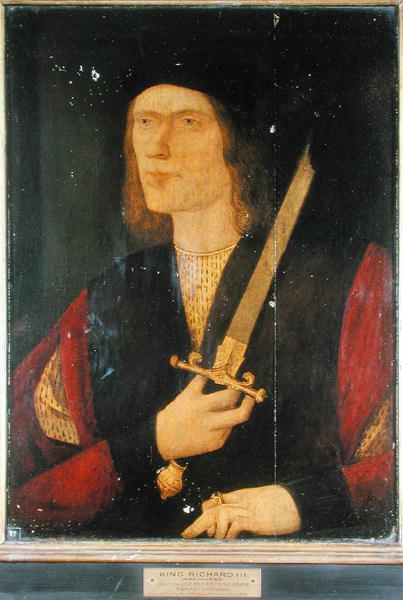

There are more than twenty portraits acknowledged to depict the last Plantagenet king of England.
These two are particularly of interest, as they are identified as mid- late sixteenth century copies of lost fifteenth century originals.
The dating of paintings is both science and art, incorporating history, details of costume, era, characteristics of brush strokes – and forensics, radio-carbon and dendrochronology dating. There is much in common with the identification of the Greyfriars, Leicester skeleton. In fact, it is tempting to surmise that the identification of bones is more exact than the identification of and dating of paint on canvas or wood panels. For one thing, DNA analysis doesn’t pertain to paint/wood/canvas. For another dendrochronolgy + radio-carbon dating are not necessarily exact.

Richard III – Broken Sword portrait (Source: Society of Antiquaries of London)
This has been dated to anywhere between 1518 and 1550. 1550 is favoured by some, as it was the time of publication of the “Sainted More’s” description of the hunchback with the withered arm. (Thomas More; 14 -15 , martyred by Henry (Tudor) VIII. More’s History of Richard III was influential in Shakespeare’s Richard III.) A broken sword can be interpreted as symbolic of failure; in a regal portrait, as symbolic of prematurely ended reign by violence, battle, deposition and usurpation. Note the narrow eyes, thin lips, deformed hand and somewhat clenched jaw. Obviously, not a trustworthy man….Richard III was an excellent target for Tudor propaganda reducing the usurped line of the Plantagenets to tyrants and debauches.

NPG 148; King Richard III by Unknown artist (Source: National Portrait Gallery)
This is my favourite portrait, as it was the inspiration for Josephine Tey’s detective in The Daughter of Time. As a result of Tey’s book, I was an ardent Ricardian for many years. Dendrochronology dates the work to c. 1590. Note the higher right shoulder suggesting some form of deformity in a portrait purportedly of the late Tudor era. (This format does not allow for graphically designing blood dripping from the highlighted name of Tudor….)
“There’s no art to find the mind’s construction in the face”.
Malcolm, act 1, scene IV MacBeth.
Perhaps not. Yet we will all react to immediate expressions in others as indications of their emotions in the moment. We will even designate a face in repose as “pleasant” or “shifty” or “mean”, or “benevolent” etc.
One of the contemporary (and considered to be most objective) descriptions of Richard III is that of “an itinerant knight from Silesia”. Niklas von Poppolau provided the following in his 1484 travel diary: “…a high-born prince, three fingers taller than I, but a bit slimmer and not as thickset as I am, and much more lightly-built; he has slender shoulders and thighs.” As with other contemporary descriptions, there is no reference to hunched back or withered arm.
Characters in The Daughter of Time react to the NPG portrait in sympathetic ways (to support the author’s thesis) to the question of the detective: what do you think of this face?
The Midget: “Liver.” A succinct nurse’s opinion.
The Surgeon: “Poliomyelitis.”
The Matron: “…the most desperately unhappy face that I have ever encountered…”
As to stature, the king was generally described as “small”. Professor Jo Appleby of the Leicester University team deduced from bone measurements that, without scoliosis, Richard III would have stood 5’8” (1.72m). The average male height today in North America is 5’8” – 5’10”. The degree of scoliosis reduced a man of good height to 1.61m. Definitely short with the spinal curvature.
As the king was continually described (as prince and king) as a great battle fighter, despite the slender build, also noted by Prof. Appleby, Richard III must have built up muscle, despite the pain of the pain of the disability. (A 15th century sword weighs between five and eight pounds. And both strength and balance must be adapted to the disability. Apparently, Usain Bolt also suffers from scoliosis.)
 NPG 148; King Richard III by Unknown artist (Source: National Portrait Gallery) |
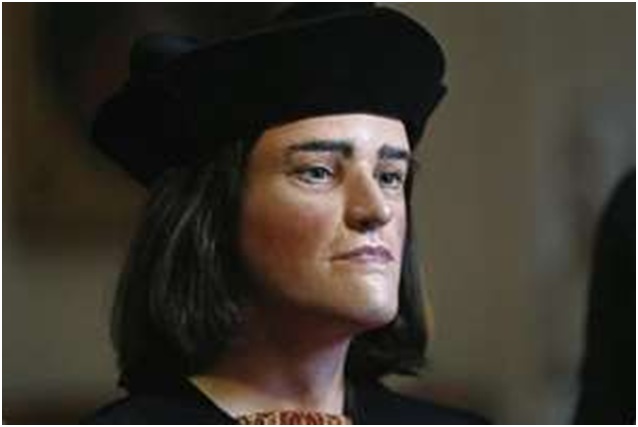 Richard III; skull reconstruction: Caroline |
Note the high cheekbones, prominent chin and not dissimilar set of the eyes and brows in these depictions. The nose of the portrait Richard is longer, with a shorter upper lip.
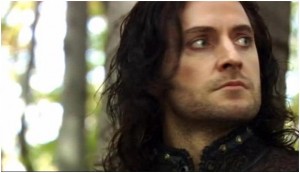
Richard Armitage (Robin Hood s3) – (Source: RANet.com)
The actor is clearly not a clone of either the portrait or of the reconstructed face. However, there is sufficient resemblance in the high cheekbones, prominent nose and delicately formed mouth for a convincing performance of the king. And many hope for the successful backing and funding for such a production to become a reality.
The perpetrator of this article descended down several rabbit holes in the process. I was sidetracked by:
- Fingerprint authentication of masterpieces;
- Dendrochronology – tree-ring dating….
- Questions pertaining to the effects of scoliosis, and the little information so far detailed by the Leicester project scientists…. more please!
- Niklas von Poppolau, “itinerant knight” from Silesia; invited to the court of Richard III; who was this man??? How did a foreign mere knight scrounge such an invitation???
It was sometimes difficult to remember what I thought was the focus of the article….but it was useful background.
SOURCES and REFERENCES
- Richard III: His Appearance; Carolyn Hammond, Richard III Society
http://www.richardiii.net.2_4_0_iii_appearance.php - Good King Richard? Jeremy Potter, 1983, reprinted by the Richard III Society
http://www.r3.org/bookcase/moremyth/html - Richard III: a study in medical misrepresentation. Isabel Tulloch for the Journal of the Royal Society of Medicine, Aug. 2009
http://jrsm.rsmjournals.com/content/102/8/315.full - Wikipedia – for general fact- and date-checking.
- Josephine Tey, The Daughter of Time; first published 1951 for some quotations.
This article was created by guest-blogger Fitzg !
– RIII-articles from the year 2012 – complete list of the year 2011 –
